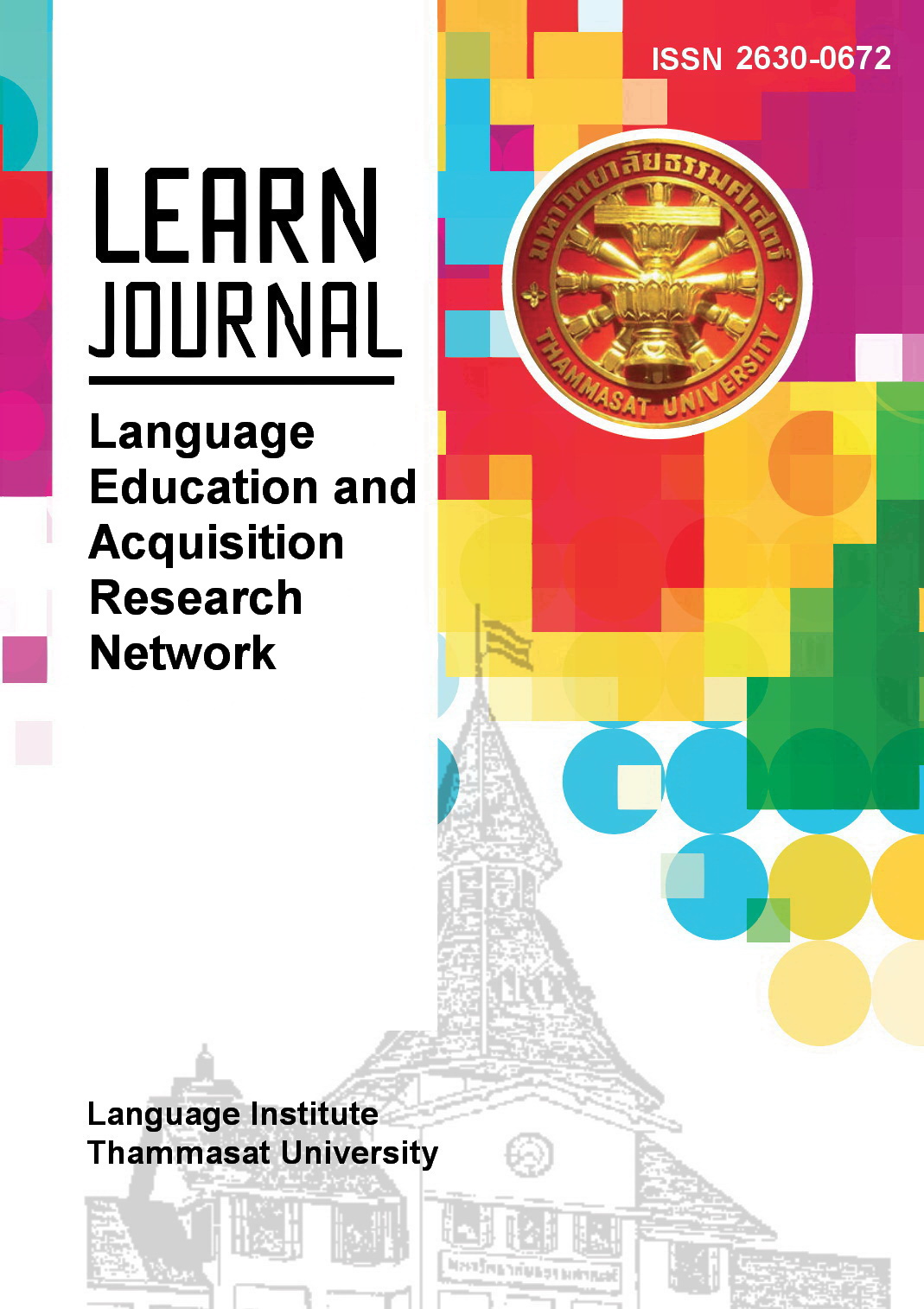High Attachment in Thai Learners’ Processing of English Relative Clauses
Main Article Content
Abstract
Resolution to ambiguity imposed by English relative clauses (RC) was examined with Thai EFL students in this study. Offline experimental items included two-site context NPs, i.e., NP1 of NP2 (Complex NP of) and NP1 with NP2 (Complex NP with) modified by RCs. As NP1 and NP2 occupy higher and lower positions in the hierarchical structure of a complex NP, RC attachment to NP1 and NP2 are termed High Attachment (HA) and Low Attachment (LA). It was hypothesized that the RC would be attached to NP1 in the Complex NP of, and NP2 in the Complex NP with, based on the Thai L1 strategy and the universal properties of thematic prepositions, respectively. Three proficiency levels, i.e., beginning, intermediate, and upper-intermediate, were established for the participants. The results confirmed both predictions. In addition, there were a rise and decline across the three proficiency levels in the employment of HA for the Complex NP of and a continuous and significant increase in the employment of LA for the Complex NP with. Overall, this study suggests the influence of an L1 strategy and the development of an L2 strategy in the absence of a corresponding L2 structure, in association with L2 employment of thematic information.
Article Details
References
Abdelghany, H., & Fodor, J. D. (1999). Low attachment of relative clauses in Arabic. Poster presented at AMLaP (Architectures and Mechanisms of Language Processing), Edinburgh, UK.
Aroonmanakun, W., Tansiri, K., & Nittayanuparp, P. (2009). Thai National Corpus: A progress report. In H. Riza & V. Sornlertlamvanich (Eds.), Proceedings of the 7th workshop on Asian language resources (pp. 153-158). Association for Computational Linguistics.
Cuetos, R., & Mitchell, D. C. (1988). Cross-linguistic differences in parsing: Restrictions on the use of late closure strategy in Spanish, Cognition, 30, 73-105.
Dussias, P. (2001). Sentence parsing in fluent Spanish–English bilinguals. In J. Nicol (Ed.), One mind, two languages: Bilingual language processing (pp. 159–176). Blackwell.
Ehrlich, K., Fernandez, E., Fodor, J. D., Stenshoel, E., & Vinereanu, M. (1999). Low attachment of relative clauses: New data from Swedish, Norwegian and Romanian. Poster presented at the 12th Annual CUNY Conference on Human Sentence Processing, New York, NY, March 18-20.
Felser, C., Roberts, L., Marinis, T., & Gross, R. (2003). The processing of ambiguous sentences by first and second language learners of English. Applied Psycholinguistics, 24, 453-489.
Fernández, E. M. (2002). Relative clause attachment in bilinguals and monolinguals. In R. R. Heredia & J. Altarriba (Eds.), Bilingual sentence processing. (pp. 187–216). Elsevier Science Publisher.
Frazier, L., & Fodor, J. D. (1978). The sausage machine: A new two-stage parsing model, Cognition, 6, 291-325.
Frazier, L., & Clifton, C. (1996). Construal. MIT Press.
Gibson, E., Pearlmutter, N., Canseco-Gonzalez, E., & Hickock, G. (1996). Recency preferences in the human sentence processing mechanism. Cognition, 59, 23-59.
Gilboy, E., Sopena, J., Clifton, C., & Frazier, L. (1995). Argument structure and association preferences in Spanish and English complex NPs. Cognition, 54, 131-167.anish and English complex NPs
Hale, K. (1983). Warlpiri and the grammar of non-configurational languages. Natural Language and Linguistic Theory, 1(1), 5-47.
Iwasaki, S., & Ingkaphirom, P. (2005). A reference grammar of Thai. Cambridge University Press.
Karimi, M. & Samadi, E. & Babaii, E. (2021). Relative clause attachment ambiguity resolution in L1-Persian learners of L2 English: The effects of semantic priming and proficiency. Journal of Modern Research in English Language Studies, 8, 153-185.
Kwon, N., Ong, D., Chen, H. & Zhang, A. (2019). The role of animacy and structural information in relative clause attachment: Evidence from Chinese. Frontiers in Psychology. Available from https://doi.org/10.3389/fpsyg.2019.01576 (accessed 2.25.2022)
Lee, Hui Hsien, & Pin Ju Wang. (2010). Syntactic ambiguity resolution in adult EFL learners In Taiwan. 南亚学报 , 30(12), 201-216.
Marefat, H., & Farzizadeh, B. (2018). Relative clause ambiguity resolution in L1 and L2: Are processing strategies transferred? Applied Linguistics, 21, 125-161.
Miyamoto, E.T. (1998). Relative clause attachment in Brazilian Portuguese. Unpublished manuscript, Massachusetts Institute of Technology, Cambridge, MA.
Miyao, M., & Omaki, A. (2005). No ambiguity about it: Korean learners of Japanese have a clear attachment preference. Poster presented at BUCLD 30, November 5, Boston, MA.
Papadopoulou, D., & Clahsen, H. (2003). Parsing strategies in L1 and L2 sentence processing: A study of relative clause attachment in Greek. Studies in Second Language Acquisition, 25, 501–528.
Pan, H. & Schimke, S. & Felser, C. (2015). Referential context effects in non-native relative clause ambiguity resolution. International Journal of Bilingualism, 19, 283-313.
Shabani, K. (2018). Resolving relative clause attachment ambiguity in Persian sentences. Lingua, 212, 10-19.
Siriwittayakorn, T., Miyamoto, E. T., Ratitamkul, T., & Cho, H. (2014). A Non-local Attachment preference in the production and comprehension of Thai relative clauses. In W. Aroonmanakun, P. Boonkwan, & T. Supnithi (Eds.), Proceedings of the 28th Pacific Asia conference on language, information and computation (pp. 575-584). Department of Linguistics, Faculty of Arts, Chulalongkorn University.
Uludağ, O. (2020). Transfer of L1 processing strategies to the interpretation of sentence-level L2 input: A cross-linguistic comparison on the resolution of relative clause attachment ambiguities. Eurasian Journal of Applied Linguistics, 6 (2) , 155-188 .


